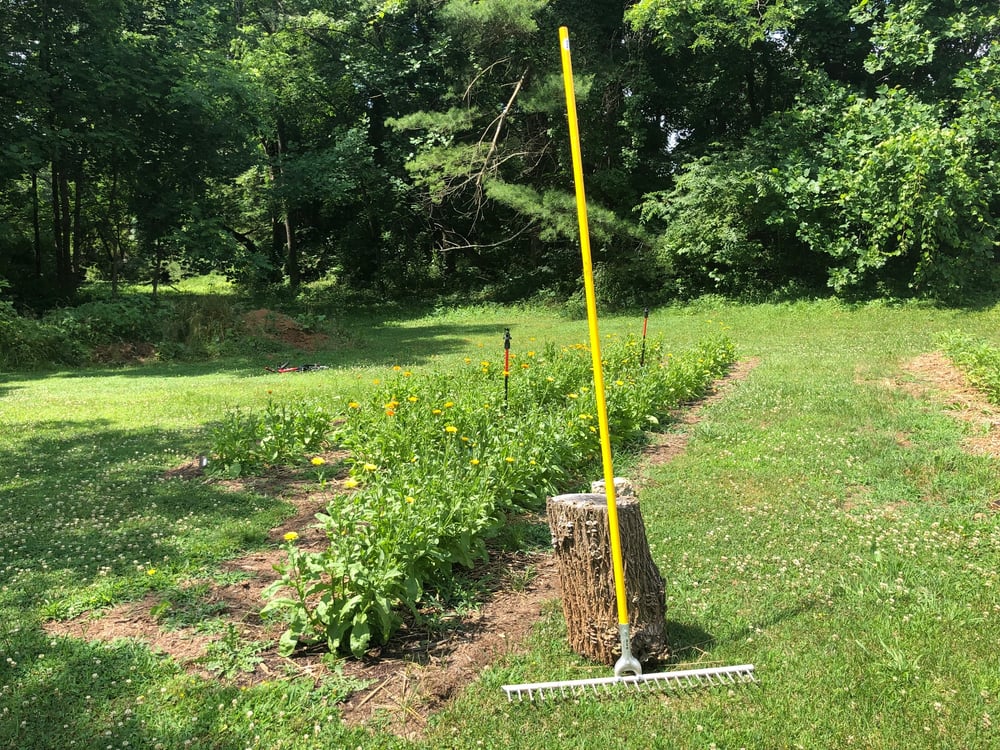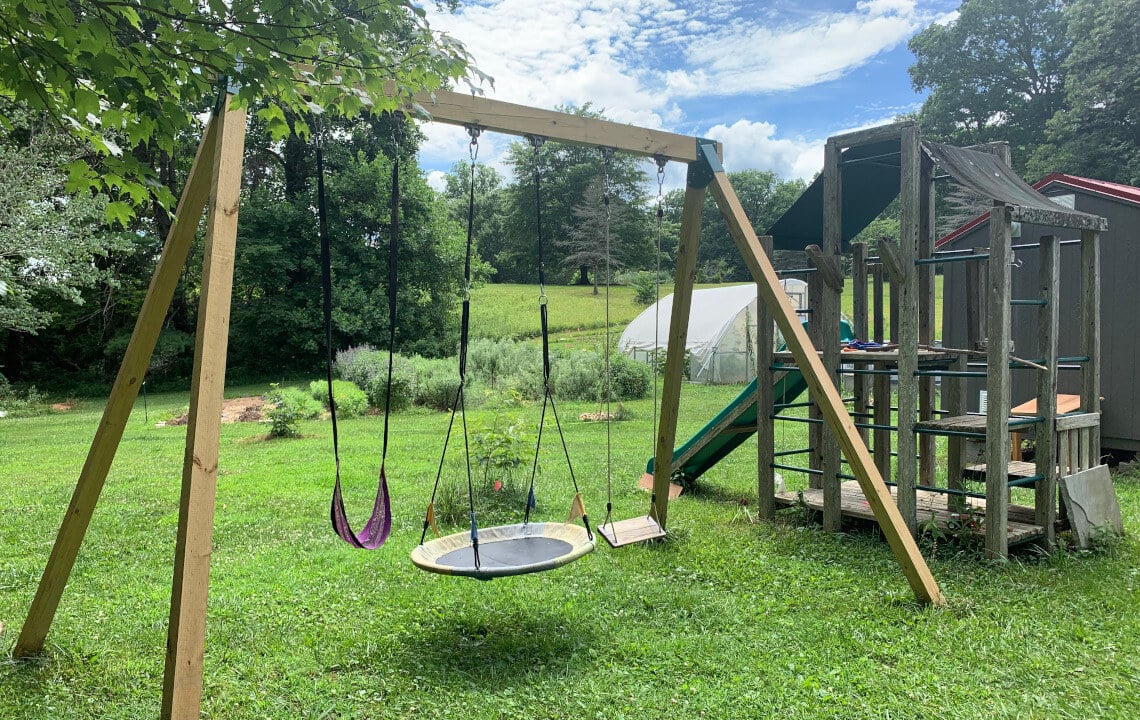When gardening or farming, having the right tool for the right job can make all the difference. A regenerative farmer and homesteader shares his picks for 5 must-have tools that will save you time, effort and sore muscles!
#1: BroadFork or Solid Digging Fork
The broadfork is a favorite tool of low-till garden operations (especially me) for bed preparation and to build healthy soil.
Broadforks are between 15 to 27 inches wide with 4 to 7 metal tines up to 16 inches long welded to a horizontal metal bar with two wooden or metal poles attached to the end. It is a lot like an oversized digging fork.

This tool is particularly popular because the fork penetrates deeply to break up compacted soil without inverting the soil like a motorized tiller.
Breaking the compaction layer aerates the soil, making it easier for roots to grow. And more importantly, creating the habitat that benefits soil biology, including earthworms.
When you use a mechanical tiller you invert the soil and pulverize it to a fine texture. This does produce a nice seed bed to plant into.
However, overtime tilling diminishes soil health by creating compaction, increasing weed pressure, lowering water-holding capacity and harming soil life (beneficial macro and microorganisms). Broadforks give the benefits of aerating/loosening the soil without inverting the soil.
My favorite broadfork is handmade in North Carolina and distributed by Earth Tools. 
The one downside to a broadfork is its heavy weight...although that does give you a good workout!
If it is too much tool to wield don’t worry, a well-made digging fork is a perfect alternative that can be used in the same way.
The downside is that a digging fork may not penetrate compacted soil as deeply and efficiently, and it takes more passes to cover the same amount of ground.
But on the upside, it is easier to work in smaller areas, is much lighter weight, cheaper and can be used to move around a variety of natural mulches like straw, leaves and woodchips.
Not all digging forks are made equal. Typically what you find at most big box hardware stores is a fork that will not last. And will quickly break if used like a broadfork.
A well made digging fork is solid, forged from one piece of carbon steel and has an extra long socket. This creates a very sturdy fork that will stand up to years of digging and abuse.
One of my favorite brands is Spear & Jackson. Their Neverbend fork is affordable and well made. Two other good examples are from Kent & Stowe and Bulldog of England.
#2: Good Soil Rake for Bed Preparation
I get a lot of joy using a functional soil rake to prepare my garden beds. The feel of smoothing out a 2 inch layer of well-made compost and raking out any debris is both satisfying and zen-like (which may sound strange to some...but not to garden geeks like me!).

Important traits to look for in a good garden rake are: one that has the same width as your garden beds, a long handle and light weight.
I have standardized my beds to 30 inches so I use a 30 inch wide rake to keep the bed width consistent.
A long handle is key because it saves you from bending over and straining your back and neck. My rake handle is 78 inches long. And, if used properly by positioning your thumbs upward, you never need to use your back. Lastly, being light weight makes it easier to push and pull.
My rake is the 30” rake with an aluminum handle at Earth Tools. This model also has an adjustable head so you can position it to the best angle for your height.
#3: Soil Blockers or Winstrip trays
If you're interested in growing super healthy starts from seed and reducing plastic, a soil blocker is a must.
I have used these for years on our homestead and professionally, and they always give my seedlings the healthiest start with zero to minimal transplant shock.
There are numerous sizes to choose from, but a great place to start is with the mini blocker combined with the 2-inch blocker.
To learn more about how to make soil blocks, links to necessary equipment and additional tips and tricks, see How To Make Soil Blocks For Waste-Free Seed Starting.

If you want a faster seed starting system with the air pruning benefits of soil blocks, a Winstrip tray is the next best thing.
Some argue even better because of the time savings. You do have to invest in plastic trays, but these trays are so durable that you will never need to throw them out. With proper care, they last forever.
The best place to go for these trays is Coner Crickmore’s Neversink Farm. Coner Crickmore is a pioneer and champion of small size no-till farming for market. Conor's website/farm has loads of interesting tools that he has designed, and he offers a great farming course that can fast track your market gardening ambitions.
#4: Stirrup Hoe
Weeding/cultivating your garden doesn’t need to be such hard work. With the right timing, disciplined consistency and the right tool, this can be an enjoyable and relatively effortless task.
The 2 keys to controlling weeds (without herbicides) are:
#1: Cultivate the soil in the weeds' early stages of growth (as they emerge). This makes them easy to eliminate.
#2: Use the right tool for the job---one that makes fast work of weeding while saving your hands and back. My favorite tool is the long-handled oscillating stirrup hoe.
These are wonderful because the long handle keeps your back upright, which means less bodily wear and tear. The blade is sharp and has an edge on both sides, allowing you to cut through weeds just below the soil surface in a push and pull motion.
Keeping the cultivation shallow (within the top two inches) is important as it prevents more weed seeds from being brought to the surface. It is also important to keep the blades sharp for effortless weeding.
Note: that the key to less work is getting weeds when they are small. That is why consistency, like weeding every 10 to 15 days, is important.
My preferred brand is the Ammann oscillating stirrup hoe made in Switzerland and sold by Earth Tools.
#5: Roo Apron

One of the most fulfilling moments of gardening is the harvest!
One basic accessory that simplifies harvesting is a Roo Apron. This apron makes it super easy to pick-and-go while placing all your produce in an convenient pouch. The apron also has many pockets for harvest tools, your phone, etc. And what I love most, is the ingenious chute that empties the pouch into a harvest bucket neat and tidy.
The apron is also helpful for carrying tools around for transplanting, carrying away deadheads and weeds to your compost or simply collecting anything that needs to be stored away.
For more insights on helpful gardening and acreage tools, check out:




-1.jpg)




















